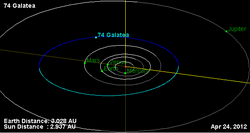Astronomy:74 Galatea
 Orbital diagram | |
| Discovery | |
|---|---|
| Discovered by | Ernst Wilhelm Tempel |
| Discovery date | August 29, 1862 |
| Designations | |
| (74) Galatea | |
| Pronunciation | /ɡæləˈtiːə/[1] |
| Named after | Galatea |
| Minor planet category | Main belt |
| Adjectives | Galatean |
| Orbital characteristics[2] | |
| Epoch December 31, 2006 (JD 2454100.5) | |
| |{{{apsis}}}|helion}} | 515.376 Gm (3.445 AU) |
| |{{{apsis}}}|helion}} | 315.937 Gm (2.112 AU) |
| 415.657 Gm (2.778 AU) | |
| Eccentricity | 0.240 |
| Orbital period | 1691.658 d (4.63 a) |
| Mean anomaly | 36.838° |
| Inclination | 4.075° |
| Longitude of ascending node | 197.313° |
| 174.519° | |
| Physical characteristics | |
| Dimensions | 120.67 ± 7.15 km[3] |
| Mass | (6.13 ± 5.36) × 1018 kg[3] |
| Mean density | 6.66 ± 5.94[3] g/cm3 |
| Rotation period | 17.270[4] h |
| Geometric albedo | 0.043 [5] |
| C[6] | |
| Absolute magnitude (H) | 8.66 |
Galatea (minor planet designation: 74 Galatea) is a large C-type main-belt asteroid. Its carbonaceous surface is very dark in color with an albedo of just 0.034.[7] Galatea was found by the prolific comet discoverer Ernst Tempel on August 29, 1862, in Marseilles, France . It was his third asteroid discovery. It is named after one of the two Galateas in Greek mythology. A stellar occultation by Galatea was observed on September 8, 1987. The name Galatea has also been given to one of Neptune's satellites.
Photometric observations of this asteroid made during 2008 at the Organ Mesa Observatory in Las Cruces, New Mexico gave a light curve with a period of 17.270 ± 0.002 hours and a brightness variation of 0.08 ± 0.01 in magnitude. The curve displays four minima and four maxima.[4] The spectra of the asteroid does not display evidence of aqueous alteration.[7]
References
- ↑ Noah Webster (1884) A Practical Dictionary of the English Language
- ↑ Yeomans, Donald K., "74 Galatea", JPL Small-Body Database Browser (NASA Jet Propulsion Laboratory), https://ssd.jpl.nasa.gov/sbdb.cgi?sstr=74, retrieved 2013-03-30.
- ↑ 3.0 3.1 3.2 Carry, B. (December 2012), "Density of asteroids", Planetary and Space Science 73 (1): 98–118, doi:10.1016/j.pss.2012.03.009, Bibcode: 2012P&SS...73...98C. See Table 1.
- ↑ 4.0 4.1 Pilcher, Frederick (September 2008), "Period Determinations for 26 Proserpina, 34 Circe 74 Galatea, 143 Adria, 272 Antonia, 419 Aurelia, and 557 Violetta", The Minor Planet Bulletin 35 (3): 135–138, Bibcode: 2008MPBu...35..135P.
- ↑ Asteroid Data Sets
- ↑ *JPL Small-Body Database Browser
- ↑ 7.0 7.1 Fornasier, S. et al. (February 1999), "Spectroscopic comparison of aqueous altered asteroids with CM2 carbonaceous chondrite meteorites", Astronomy and Astrophysics Supplement 135: 65−73, doi:10.1051/aas:1999161, Bibcode: 1999A&AS..135...65F, https://ui.adsabs.harvard.edu/link_gateway/1999A&AS..135...65F/PUB_PDF.
External links
- 74 Galatea at AstDyS-2, Asteroids—Dynamic Site
- 74 Galatea at the JPL Small-Body Database
 |

